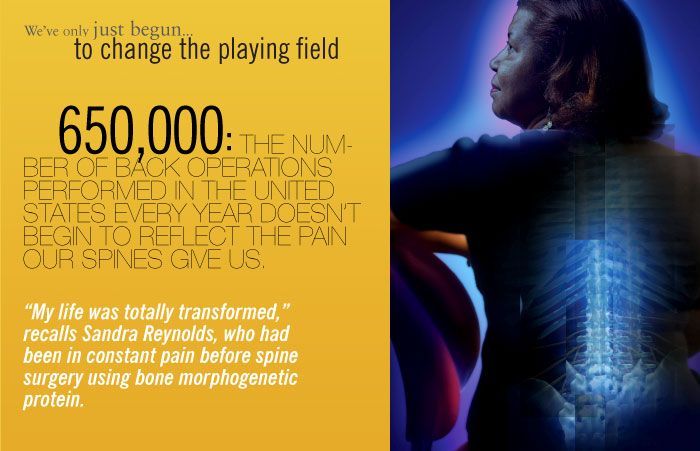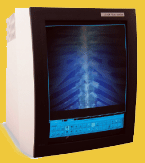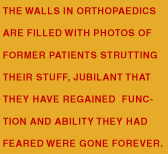
 and Spine Center, Reynolds told him she could no longer live with the pain,
dependence on pills, and inactivity. Boden told her she needed surgery to
fuse the vertebrae in her injured back. He also explained that she would
need a bone graft, with healthy bone tissue harvested from a second surgical
site, to make the repair.
and Spine Center, Reynolds told him she could no longer live with the pain,
dependence on pills, and inactivity. Boden told her she needed surgery to
fuse the vertebrae in her injured back. He also explained that she would
need a bone graft, with healthy bone tissue harvested from a second surgical
site, to make the repair.Harvesting bone tissue for grafting has traditionally been highly invasive, with so much tissue needed from the harvest site that it can become a new source of chronic pain for the patient. Thanks to recent research led by Boden, however, Reynolds could benefit from a procedure that was less painful and more effective than conventional approaches.
Boden had led clinical trials of a genetically engineered version of a bone morphogenetic protein (BMP) that causes nearby stem cells to turn into new bone (the same protein and process through which broken bones heal normally). He used BMP to augment Reynolds’ own tissue and thus minimize the amount needed from the harvest site. BMP also increased the success and speed of bone healing at the site of injury where the graft was implanted.
“My life was totally transformed,” recalls Reynolds, back to most of her old activities a year after surgery.
Reynolds’ story was not unusual. With Food and Drug Administration approval for BMP, Boden is already at work on the next phase. He has discovered another gene for a growth protein that he expects to be more potent and more affordable than the first and able to regenerate other tissues in addition to bone. Until he finds the answer, he won’t slow down either.
| Next
chapter: to sharpen our sights for the future>> |
||
|
|
|||||||||||||||||||||||||||||||||||||||||||||||||||||||||||||||
Copyright
© Emory University, 2006. All Rights Reserved
 one roof and all relevant specialists under one team coach.
For example, all Emory spine surgeons, whether their
training is in orthopaedics or neurosurgery, are now together
in one location, helping ensure a team approach to both care
and research. Such coordinated care is a proven model
for getting the best results in patient care, whatever the specialty.
This game plan is particularly important in orthopaedics, in
view of the fact that more people will need to see an orthopaedist
in their lifetime than any other kind of specialist.
one roof and all relevant specialists under one team coach.
For example, all Emory spine surgeons, whether their
training is in orthopaedics or neurosurgery, are now together
in one location, helping ensure a team approach to both care
and research. Such coordinated care is a proven model
for getting the best results in patient care, whatever the specialty.
This game plan is particularly important in orthopaedics, in
view of the fact that more people will need to see an orthopaedist
in their lifetime than any other kind of specialist.
